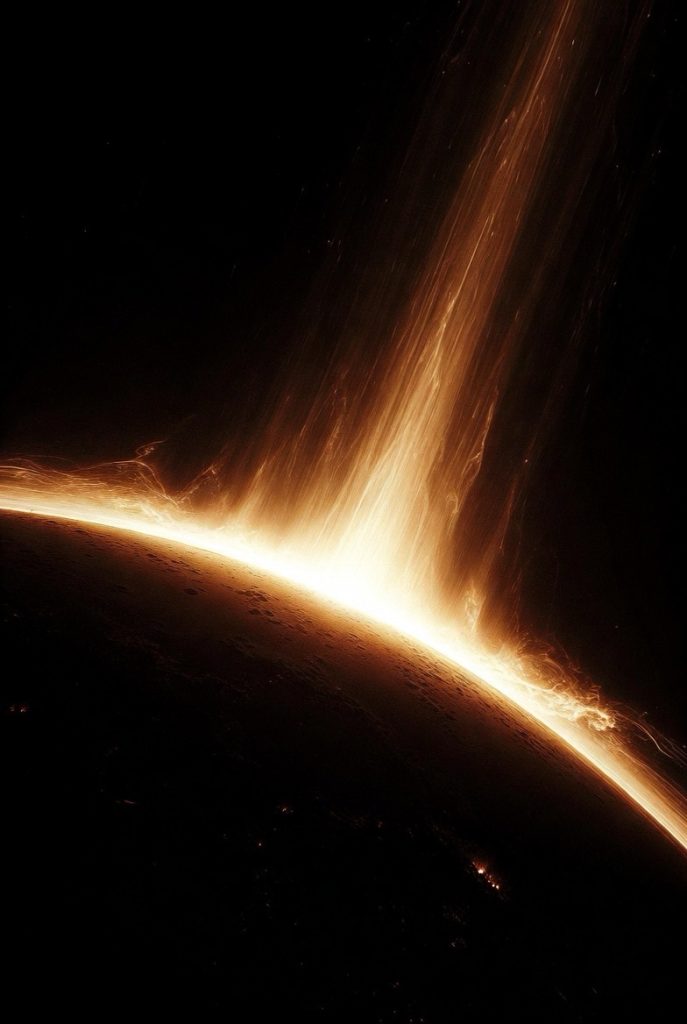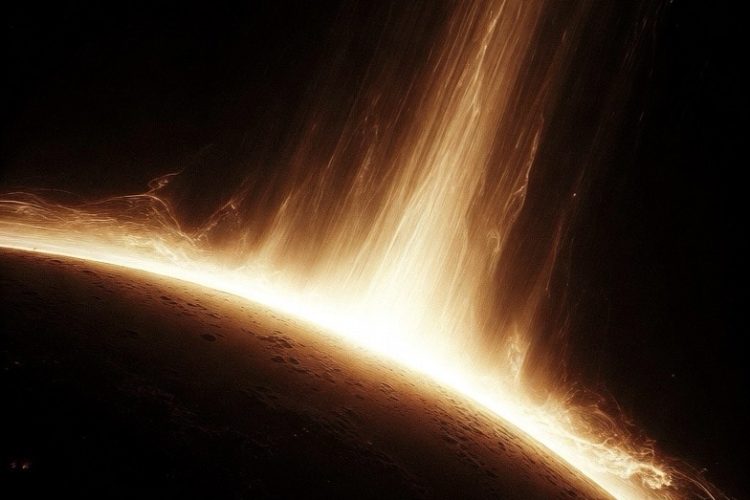On November 11, 2025, a powerful X5.1 solar flare erupted from sunspot AR4274 during solar cycle 25’s peak, causing R3-level radio blackouts across Africa and Europe. The flare’s soft X-rays ionized the ionosphere, disrupting high-frequency (HF) radio used in aviation, maritime, and emergency services, while also causing GPS errors and radar interference. A coronal mass ejection (CME) followed, expected to deliver a glancing blow to Earth’s magnetosphere by late November 12, potentially triggering a G4 geomagnetic storm and vivid auroras. Such X-class flares, far stronger than M-class, highlight risks to communication and power systems during solar maximum. Space weather monitoring helps predict and mitigate impacts, urging industries to adopt resilient tech and backup systems.
Long Version
Massive Solar Flare Hits 2025 Peak: Africa and Europe Face Radio Blackouts
In the early hours of November 11, 2025, the Sun unleashed a massive solar flare, marking the strongest eruption of the year and intensifying concerns about space weather impacts on Earth. This X-class flare, peaking at X5.1, originated from the highly active sunspot region AR4274 and triggered widespread radio blackouts across Africa and Europe. As solar cycle 25 reaches its solar maximum, events like this highlight the Sun’s dynamic influence on our planet’s communication systems and beyond.
The Event: A Powerful X-Class Flare Erupts
The solar flare erupted at approximately 5:00 a.m. EST (1000 GMT), classified as an X5.1 on the space weather scale. This places it firmly in the X-class category, the most intense type of solar flares, which are ten times stronger than M-class flares and capable of releasing energy equivalent to billions of hydrogen bombs. The flare was accompanied by a burst of soft X-rays, which ionized the upper layers of Earth’s atmosphere, specifically the ionosphere, leading to immediate disruptions.
Shortly after the eruption, a coronal mass ejection (CME) was detected hurling toward Earth. CMEs are massive clouds of solar plasma and magnetic fields that can interact with Earth’s magnetosphere, potentially causing geomagnetic storms. In this case, models suggest the CME could deliver a glancing blow to Earth late on November 12, escalating the risk of a G4-level geomagnetic storm by November 12 and 13. This solar storm follows a series of recent activity from AR4274, including an X1.8 flare on November 4 that already caused radio outages over parts of the Western Hemisphere and West Africa.
Space weather experts have been monitoring solar cycle 25 closely, as it approaches its predicted peak in mid-to-late 2025. The cycle, which began in December 2019, has seen an uptick in sunspot activity, with AR4274 emerging as one of the most prolific flare producers. This flare’s timing aligns with the solar maximum phase, where the Sun’s magnetic field flips, increasing the frequency of such eruptions. During this period, the Sun’s surface becomes more turbulent, with magnetic loops twisting and snapping, releasing pent-up energy in the form of flares and CMEs.
Understanding Solar Flares and Their Mechanisms
Solar flares are sudden releases of magnetic energy stored in the Sun’s atmosphere, often occurring near sunspots where magnetic fields are tangled and unstable. They emit radiation across the electromagnetic spectrum, including soft X-rays that reach Earth in just eight minutes. Upon arrival, these X-rays interact with the ionosphere—a layer of Earth’s atmosphere extending from about 50 to 600 miles altitude—causing it to expand and absorb high-frequency (HF) radio signals.
This absorption leads to radio blackouts, classified on the space weather scale from R1 (minor) to R5 (extreme). The November 11 event registered as an R3-level blackout, indicating strong disruptions lasting up to an hour on the sunlit side of Earth. In contrast, M-class flares might cause milder R1 or R2 effects, but X-class events like this one amplify the impact significantly. The intensity of a flare is measured by its peak flux in the soft X-ray band, with X-class flares exceeding 10^-4 watts per square meter.
When a CME follows, as in this instance, it can compress Earth’s magnetosphere—the protective magnetic bubble shielding our planet from solar particles. A direct hit could trigger a geomagnetic storm, rated from G1 (minor) to G5 (extreme), potentially enhancing aurora displays while posing risks to satellites and power grids. The speed of the CME, often exceeding 1,000 kilometers per second, determines the arrival time and potential severity, with faster ejections leading to more abrupt geomagnetic disturbances.
Immediate Impacts: Radio Blackouts and Communication Disruptions
The flare’s effects were felt almost immediately in Africa and Europe, where the sunlit side faced the brunt of the disruption. High-frequency (HF) radio communications, essential for aviation communication, maritime radio, and emergency services, experienced severe blackouts. Pilots and air traffic controllers reported temporary radio outages, while ships at sea encountered maritime radio interference, complicating navigation and coordination.
Radar interference was also noted, affecting systems reliant on HF bands for long-range detection. In regions like southern Africa and parts of Europe, the blackout disrupted emergency services’ ability to communicate effectively during the peak hours. Additionally, GPS disruption occurred due to ionospheric scintillation, where signal paths become erratic, leading to positioning errors of several meters—critical for aviation and maritime operations. These errors arise because the ionosphere’s density fluctuations scatter satellite signals, reducing accuracy in real-time positioning.
These blackouts underscore the vulnerability of modern communication infrastructure to space weather. Unlike a glancing blow from a CME, which might cause delayed geomagnetic effects, the flare’s X-ray pulse causes instantaneous disruption on the day side of Earth. In densely populated areas, such events can cascade into broader issues, like delayed flights or hindered search-and-rescue operations.
Broader Implications for Earth and Society
Beyond immediate blackouts, the impending geomagnetic storm from the associated CME could extend impacts globally. Enhanced aurora visibility is expected as far south as the northern United States and parts of Europe, resulting from charged particles exciting atmospheric gases. However, stronger storms can induce currents in power lines, potentially leading to grid instability, though forecasters rate this event as moderate. Historical precedents, such as the 1989 Quebec blackout caused by a G5 storm, illustrate how induced geomagnetic currents can overload transformers and cause widespread power outages.
In the context of solar cycle 25, this flare exemplifies the heightened activity during solar maximum. Historical cycles show that peaks bring more frequent solar storms, with potential for widespread disruption. For instance, past events have caused satellite malfunctions and communication failures, emphasizing the need for resilient systems. On a societal level, industries like telecommunications, finance, and energy are increasingly at risk, as solar storms can interfere with undersea cables, stock trading platforms, and oil pipelines through electromagnetic induction.
Economically, the costs of such events can run into billions, factoring in lost productivity and repair expenses. Environmentally, while auroras provide stunning natural displays, increased particle influx can affect atmospheric chemistry, potentially depleting ozone in polar regions temporarily.
Monitoring and Mitigation: Preparing for Future Events
Agencies continuously track space weather using satellites such as the Solar Dynamics Observatory and the Solar Ultraviolet Imager. Predictions for solar cycle 25 indicate a maximum sunspot number around 115, with activity persisting until about 2030. Operators in affected sectors, including aviation and emergency services, receive alerts to switch to alternative frequencies or delay operations during blackouts.
To mitigate risks, industries are investing in hardened electronics and backup systems, such as Faraday cages for critical equipment and redundant satellite networks. Public awareness of space weather forecasts can also help, as individuals in high-latitude areas prepare for potential aurora sightings or minor disruptions. Advanced modeling techniques, including machine learning algorithms, are being developed to predict flare occurrences more accurately by analyzing sunspot evolution and magnetic field configurations.
International collaboration plays a key role, with organizations sharing data to create global early-warning systems. For future solar cycles, which occur roughly every 11 years, ongoing research into the Sun’s dynamo—the process generating its magnetic field—aims to refine long-term forecasts, potentially reducing vulnerabilities in an increasingly connected world.
This November 11 solar flare serves as a stark reminder of the Sun-Earth connection. As solar cycle 25 continues its peak, staying informed about space weather remains crucial for minimizing disruptions and harnessing the awe-inspiring phenomena like auroras that accompany these powerful solar storms. By enhancing infrastructure resilience and advancing scientific understanding, society can better navigate the challenges posed by our star’s volatile behavior.









